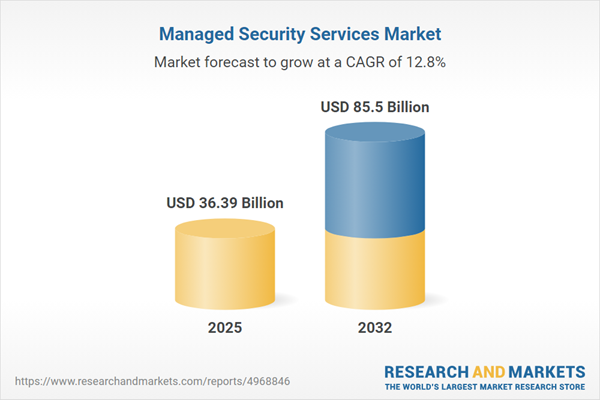Speak directly to the analyst to clarify any post sales queries you may have.
Senior executives overseeing cybersecurity strategies recognize the imperative need for adaptive, comprehensive solutions as threats and regulations increase in complexity. The managed security services market is quickly evolving, driven by technological innovation, shifting compliance requirements, and external economic pressures demanding new approaches to risk mitigation and service delivery.
Market Snapshot: Managed Security Services Market Size and Forecast
The managed security services market grew from USD 32.51 billion in 2024 to USD 36.39 billion in 2025, with continued expansion at a CAGR of 12.84% expected to reach USD 85.50 billion by 2032. This strong trajectory underscores the pace of digital transformation across all sectors, heightened threat actor sophistication, and rising enterprise reliance on trusted third-party providers for critical security operations.
Scope & Segmentation
This research offers an in-depth analysis across the core segments, deployment models, and regional markets shaping the future of managed security services. These segments provide actionable clarity for senior leaders evaluating strategic investments, technology adoption, and expansion opportunities.
- Service Types: Managed detection and response, managed firewall, managed identity and access management, managed risk and compliance management, managed SIEM and log management, and managed vulnerability management.
- Engagement Models: Co-managed security service and fully-managed security services.
- Security Domains: Application security, cloud security, endpoint security, and network security.
- Deployment Preferences: On-cloud and on-premises solutions.
- Organization Size: Large enterprises and small and medium-sized enterprises.
- Industry Verticals: Aerospace and defense, banking, financial services and insurance, energy and utilities, government and public sector, healthcare, IT and telecommunications, manufacturing, and retail.
- Geographic Regions: Americas, Europe, Middle East & Africa, and Asia-Pacific, with dedicated country-level analysis in key markets including the United States, Canada, Brazil, Germany, United Kingdom, China, India, Japan, Australia, and more.
- Leading Technology Providers: Accenture PLC, Alert Logic by Fortra, Ascend Technologies, AT&T Inc., Atos SE, BAE Systems plc, Broadcom Inc., Capgemini Services SAS, CenturyLink, Cisco Systems, CrowdStrike, DXC Technology, Fortinet, Happiest Minds Technologies, IBM Corporation, Kyndryl, Lumen Technologies, Motorola Solutions, Netsurion, NTT Ltd., Optiv Security, Tata Communications, Trustwave Holdings, Unisys, and Wipro Limited.
Key Takeaways for Senior Decision-Makers
- Rapid adoption of artificial intelligence and automation within security operations increases detection accuracy and enables advanced orchestration, aligning protection with evolving threat vectors and business needs.
- Stringent and dynamic regulatory mandates have transformed compliance from a discrete project into a core managed service necessity for enterprises across most regulated industries.
- Hybrid and multi-cloud environments require seamless integration of controls and continuous monitoring, making scalable deployment models an important consideration for future-readiness.
- Shifts toward outcome-based security models are driving service evolution from basic monitoring to end-to-end incident response and remediation, fostering resilience through proactive strategies.
- Growth in strategic alliances between telecom providers, security innovators, and IT conglomerates is leading to expanded service portfolios and unified solutions tailored to global, multi-site operations and remote workforces.
Tariff Impact on Service Models and Supply Chains
Recent United States tariff measures have raised costs across hardware-dependent segments, prompting providers to prioritize software-centric and cloud-native platforms. These adjustments have accelerated collaboration among technology partners and fostered joint innovation. The shift reduces reliance on hardware, enhances service flexibility, and enables improved cost efficiencies. Strategic realignment toward virtualized infrastructure supports ongoing service performance even amid macroeconomic pressures and supply chain uncertainties.
Methodology & Data Sources
This analysis leverages a mixed-method research framework, combining interviews with senior executives across major enterprises and providers with in-depth reviews of industry publications and regulatory filings. Quantitative analyses are supported by statistical modelling, while thematic coding and sentiment analysis validate emergent trends. Anonymized perspectives ensure confidentiality and data integrity throughout the study.
Why This Report Matters
- Enables leadership teams to make informed investment decisions and prioritize security initiatives amid changing regulatory and threat environments.
- Equips security strategists and IT directors with critical insights on technology trends, service delivery models, and regional adoption patterns.
- Supports procurement and compliance professionals in benchmarking providers and selecting solutions aligned with specific industry and organizational needs.
Conclusion
Organizations navigating the managed security services market benefit from actionable insights into technological, regulatory, and economic drivers shaping enterprise defense strategies. Leveraging this analysis equips decision-makers with practical frameworks for achieving resilience and sustained competitive advantage within a rapidly evolving landscape.
Additional Product Information:
- Purchase of this report includes 1 year online access with quarterly updates.
- This report can be updated on request. Please contact our Customer Experience team using the Ask a Question widget on our website.
Table of Contents
3. Executive Summary
4. Market Overview
7. Cumulative Impact of Artificial Intelligence 2025
Companies Mentioned
The companies profiled in this Managed Security Services market report include:- Accenture PLC
- Alert Logic, Inc. by Fortra
- Ascend Technologies
- AT&T Inc.
- Atos SE
- BAE Systems plc
- Broadcom Inc.
- Capgemini Services SAS
- CenturyLink, Inc.
- Cisco Systems, Inc.
- CrowdStrike
- DXC Technology Company
- Fortinet, Inc.
- Happiest Minds Technologies Pvt. Ltd.
- International Business Machines Corporation
- Kyndryl Inc.
- Lumen Technologies
- Motorola Solutions, Inc.
- Netsurion LLC
- NTT Ltd.
- Optiv Security Inc.
- Tata Communications Limited
- Trustwave Holdings, Inc.
- Unisys Corporation
- Wipro Limited
Table Information
| Report Attribute | Details |
|---|---|
| No. of Pages | 184 |
| Published | November 2025 |
| Forecast Period | 2025 - 2032 |
| Estimated Market Value ( USD | $ 36.39 Billion |
| Forecasted Market Value ( USD | $ 85.5 Billion |
| Compound Annual Growth Rate | 12.8% |
| Regions Covered | Global |
| No. of Companies Mentioned | 26 |









